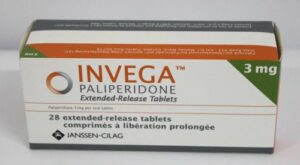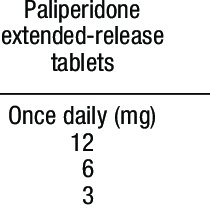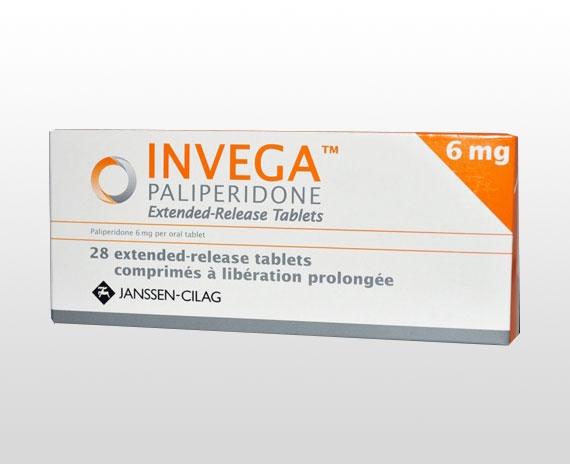Contents
- 1 What Is Paliperidone (Invega)?
- 2 How Does Paliperidone Work?
- 3 Benefits Of Paliperidone (Invega)
- 4 Who Should Take Paliperidone (Invega)?
- 5 How Effective Is Paliperidone (Invega)?
- 6 Side Effects Of Paliperidone (Invega)
- 7 How To Take Paliperidone (Invega)?
- 8 Tips For Living With Schizophrenia Or Bipolar Disorder
- 9 Dosage Of Paliperidone
- 10 Drug Interaction
- 11 Conclusion
What Is Paliperidone (Invega)?

Paliperidone, also known by its brand name Invega, is a medication used to treat schizophrenia and bipolar disorder. It is a long-acting atypical antipsychotic agent that belongs to the phenothiazine class of medications. Paliperidone works by blocking dopamine receptors in the brain, which helps to improve symptoms of schizophrenia and bipolar disorder.
Paliperidone (trade name Invega) was first approved by the U.S Food and Drug Administration in 2006. It was used to treat people suffering from schizophrenia and bipolar disorder who had not responded well enough to a previously prescribed antipsychotic medication.
How Does Paliperidone Work?

Paliperidone works by blocking dopamine receptors in the brain. Dopamine is a neurotransmitter that helps to control mood and emotions. When paliperidone blocks dopamine receptors, it helps to improve symptoms of schizophrenia and bipolar disorder.
Paliperidone is a member of the piperidine class of atypical antipsychotics, which means it works differently from typical sulfa-based dopamine blockers such as haloperidol and it exhibits low extrapyramidal side effects. This means that Paliperidone has a low chance of causing Parkinson’s symptoms in those who take it. However, Parkinson’s disease patients have been shown to have higher amounts of fat accumulation in certain areas of the brain, so they should discuss with their doctor if being treated with drugs containing paliperidone before starting a diet regimen. According to studies done on rats and monkeys, weight gain has been noted to be a significant factor in medication-related death if maintained over a long period of time.
Benefits Of Paliperidone (Invega)
The benefits of Invega include improvement in symptoms such as-
- Delusions
- Hallucinations
- Disorganized speech and thoughts
- Lack of attention to personal hygiene
- Bipolar disorder
Efficacy was found in a randomized controlled trial examining once-daily doses of either 3 mg or 6 mg over a period of 1 year. Improvement was shown across the following scales: PANSS scores for schizophrenia, CGI scale for severity and improvement and YMRS scores specifically dedicated to measuring mania/hypomania symptoms.
Paliperidone is used to treat schizophrenia and bipolar disorder, otherwise known as manic depression. A major symptom of the illness process that schizophrenia sufferers experience is delusions or hallucinations. This can be extremely serious depending on the context in which they occur; if the person experiencing them believes they are being watched it may lead to self-harm or even suicide among other things depending on how intense it happens to be. The same goes for those who experience hallucinations because their mental state will play a factor in determining whether or not the hallucination is significant enough to think about harming themselves.
Who Should Take Paliperidone (Invega)?

Paliperidone is only available through a doctor’s prescription so you will need to talk with them about whether or not you should take it. Paliperidone may be an option if you have schizophrenia or bipolar disorder. It is also used to treat irritability associated with autism.
How Effective Is Paliperidone (Invega)?
Paliperidone has been found to reduce the symptoms of schizophrenia and bipolar disorder in clinical studies. Although it primarily works by blocking dopamine receptors, researchers believe that the mechanism of action against psychosis is complex and poorly understood. Paliperidone affects neurotransmitters in the brain such as dopamine and serotonin. These neurotransmitters can be found in specific areas of the brain such as the hypothalamus and thalamus, among others. It allows for it to affect feelings such as motivation or cognition.
Side Effects Of Paliperidone (Invega)
 Common side effects include-
Common side effects include-
- Tremors
- Restlessness
- Anxiety
- Headache
- Blurred vision
- Nausea/vomiting/diarrhea
- Constipation
- Fast heart rate
- Low blood pressure
Paliperidone has been shown to lead to increased appetite, weight gain, restlessness, and fatigue. Paliperidone also increases insulin resistance which can cause diabetes mellitus or its precursor known as glucose intolerance. Insulin resistance can also lower testosterone levels for men leading them to experience negative body changes such as decreased muscle mass or increased amounts of abdominal fat.
How To Take Paliperidone (Invega)?
Currently, paliperidone can only be dispensed by your doctor. How often you receive it will depend on your condition and how well it is working for you. It may need to be increased slowly over several week or months before you reach the maintenance dose.
Do not stop taking paliperidone in order to maintain the best possible effect for you. Here are some tips to remember when taking Paliperidone:
- Take pills with food to decrease nausea/vomiting/diarrhea or avoid eating 2 hours before or after taking Paliperidone because food reduces the absorption of the medication into the body. It is not recommended that you take this medication on an empty stomach because it may cause vomiting or diarrhea.
- Paliperidone can be taken with or without food and should be swallowed whole so you should not break, chew, crush or dissolve it before swallowing. If you need to take this medication during the day and cannot eat 2 hours beforehand or after because of your schedule, you can try to change your schedule and find a time when you can eat beforehand and afterward.
- Some people may also experience drowsiness as a side effect of Paliperidone; therefore, avoid activities that require mental alertness such as driving or operating dangerous machinery until the full effects of Paliperidone are seen as it may cause drowsiness during any stage of treatment.
Tips For Living With Schizophrenia Or Bipolar Disorder

- Get regular exercise because it reduces the symptoms of schizophrenia and bipolar disorder.
- Avoid alcohol or street drugs as they can worsen symptoms or cause psychotic episodes.
- Learn about schizophrenia and bipolar disorder to help you understand what you are going through, take medications correctly, keep track of your treatment, learn how to handle stressors in your life, and know what to do if side effects occur.
- Establish a peer support network by talking with other people who have schizophrenia or bipolar disorder so that you have someone to turn to for emotional support during times of difficulty.
- Try not to spend too much time alone as this increases feelings of isolation which can worsen symptoms. You may join a club or group that you can attend regularly, such as a book club or gym.
- If you feel like you would benefit from talking about your illness with a therapist, make an appointment to speak with one and make it happen even if it takes some effort on your part. It is important to take the necessary steps towards managing your condition and this may require getting therapy.
- Keep taking medications even if you are feeling better for at least 3 years unless told otherwise by your doctor.
Dosage Of Paliperidone
 The recommended dosage of Paliperidone differs from patient to patient due to differences in body weight, other medications being used, and possibly genetic factors. However, it is recommended that Paliperidone be taken orally with a glass of water. At a dose range of 3 to 12mg per day for those suffering from bipolar disorder. And up to 18mg per day for those suffering from schizophrenia. If the first prescribed medication does not work as intended or causes too many side effects. Then it can be changed or removed at one’s discretion.
The recommended dosage of Paliperidone differs from patient to patient due to differences in body weight, other medications being used, and possibly genetic factors. However, it is recommended that Paliperidone be taken orally with a glass of water. At a dose range of 3 to 12mg per day for those suffering from bipolar disorder. And up to 18mg per day for those suffering from schizophrenia. If the first prescribed medication does not work as intended or causes too many side effects. Then it can be changed or removed at one’s discretion.
Paliperidone comes in forms such as tablets, orally disintegrating tablets (which dissolve within seconds once placed under the tongue). And an oral solution, and an autoinjector pen filled with 1-month long doses of medication. This must be injected using a needle by medical staff who have been trained to do so. Each pen holds a maximum of 30 units and the liquid contained within is a mixture of paliperidone palmitate. That is a lipid-soluble ester and an ethanol solution. The medication can be injected into the gluteus or thigh. As long as it is not being used on areas with open wounds or infections. Also injections should always be administered by those who have been properly trained in how to use the autoinjector pen.
Drug Interaction
Paliperidone has been shown to have interactions with other medications such as ketoconazole, itraconazole, and erythromycin. These are known inhibitors of the hepatic enzyme CYP3A4 which is responsible for metabolizing the medication. This causes Paliperidone levels to go up making side effects more likely to occur while increasing the risk for serotonin syndrome.
Pharmacokinetics are affected by food items containing high amounts of lipids or fat. Since they can alter its absorption, distribution, and elimination. Therefore, leading to inconsistent plasma concentrations. Food also affects how much time Paliperidone will remain in one’s system with peak plasma concentrations being delayed when taken with a meal.
Conclusion
Paliperidone (Invega) is a medication that was approved in 2011 for the treatment of schizophrenia. It’s an atypical antipsychotic drug and it works by interfering with communication between nerve cells in the brain. Paliperidone can be taken once or twice daily, depending on your doctor’s recommendations. Side effects from taking this medicine may include sedation, weight gain, diabetes risk, high blood sugar levels and increased cholesterol levels. If you need more knowledge about paliperidone side effects, reach out to us and talk to our doctor.
If you are looking for affordable Online Counseling MantraCare can help: Book a trial therapy session


